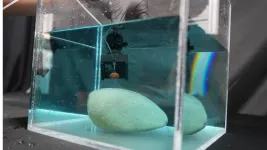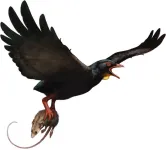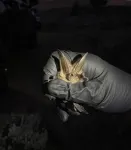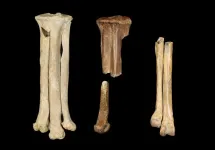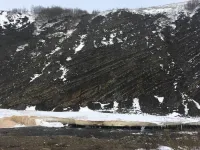(Press-News.org) Using mechanisms inspired by nature to create new technological innovations is a signature of one Virginia Tech research team. The group led by Associate Professor Michael Bartlett has created an octopus-inspired adhesive, inspired by the shape of octopus suckers, that can quickly grab and controllably release challenging underwater objects.
Having the ability to grab and release these underwater objects like heavy rocks, small shells, and soft beads, and other debris could be a powerful tool for underwater salvage and even rescue operations. Their findings have been published in Advanced Science.
This work was performed with undergraduate researchers Austin Via, Aldo Heredia, and Daniel Adjei from Virginia Tech. Graduate Research Assistant Chanhong Lee was first author on the paper, reporting research supported by the National Science Foundation through the Designing Materials to Revolutionize and Engineer our Future program.
“I am fascinated with how an octopus in one moment can hold something strongly, then release it instantly. It does this underwater, on objects that are rough, curved, and irregular - that is quite a feat,” Bartlett said.
Getting a grip underwater
To overcome this longstanding challenge, Bartlett and his team looked to the shape of the octopus. Specifically, they looked at the outer structure of the octopus's sucker, called the infundibulum. This inspired the researchers to create an adhesive that utilizes an elastic, curved stalk with an active, deformable membrane that changes shape for multi-surface adhesion.
The curved stalk attaches to large-scale curvatures while increasing adaptability to small-scale roughness. These mechanisms work in synergy to improve adhesion across multiple length scales.
This resulted in octopus-inspired adhesives that are 1,000 times stronger when activated compared to the easy release state. Importantly, this switch occurs within a fraction of a second, about 30 milliseconds. The octopus-inspired adhesives now achieve high attachment strength on diverse surfaces, including rough, curved, and irregular objects as well as in different fluids. With this new tool, a diver could hold a slippery object without applying excessive squeezing, also being able to snatch it quickly with rapid switching.
Grip and release of challenging underwater objects
Because octopus suckers are made of living tissue, they warp, expand and contract to match the job they are approaching. This gives the animal not only a stronger grip, but also a versatility to adapt its hold as it finds objects that are smooth or rough, angular or flat.
With the new octopus-inspired adhesive, research team members can pick up, hold, and release a wide range of challenging underwater objects, including soft and rigid materials that are flat, rough, and even curved.
This capability was demonstrated by constructing an underwater cairn, a carefully constructed pile of underwater rocks. Here, the rocks have various sizes, shapes, and surface roughness and must be picked up but also precisely released to keep the structure balanced. At the same time, they can also grab and release soft, jelly-like beads with ease.
“These types of manipulations are performed by an octopus as they arrange objects around their den,” said Lee. “This demonstration highlights the ability of the octopus-inspired adhesive to precisely manipulate difficult underwater objects.”
The materials also show reliable attachment over multiple cycles and over an extended period of time. In one experiment, the attachment force stayed constant over 100 cycles. In another test, the team held a rough, curved rock for more than seven days underwater, then released it on demand. Particularly in salvage applications where holding an object over an extended period of time, this could be critical.
Gripping like an octopus
Bartlett previously created Octa-Glove, published in Science Advances. Octa-Glove has octopus-inspired adhesives equipped with LIDAR sensors that detected objects nearby, attaching to the object with a strong but gentle bond without applying excessive force. After capture, the suckers can be disengaged on demand, releasing the captured object.
The glove could be a valuable tool for rescue divers, underwater archaeologists, user-assisted technologies, and in health care or other similar work that involves the need to have a firm grip on wet or underwater objects. This recently published research could increase the capacity of the glove, making the grip even stronger.
“We hope to utilize our new adhesive design to further improve Octa-Glove," said Bartlett said. "Underwater environments present a long list of challenges, and this advance gets us over another hurdle. We’re now closer than ever to replicating the incredible ability of an octopus to grip and manipulate objects with precision, opening up new possibilities for exploration and manipulation of wet or underwater environments.”
END
New research on octopus-inspired technology successfully maneuvers underwater objects
2024-10-09
ELSE PRESS RELEASES FROM THIS DATE:
Newly discovered Late Cretaceous birds may have carried heavy prey like extant raptors
2024-10-09
Newly discovered ancient birds from Late Cretaceous North America were hawk-sized and had powerful raptor-like feet, according to a study published October 9, 2024 in the open-access journal PLOS ONE by Alexander Clark of the University of Chicago, U.S. and colleagues.
The most diverse birds during the Cretaceous Period were a now-extinct group called enantiornithines, known from all over the world during this time. However, enantiornithines and other Mesozoic birds are mainly known from Lower Cretaceous deposits, with a relatively poor record ...
Bat species richness in San Diego, C.A. decreases as artificial lights, urbanization, and unconserved land increase, with Townsend's big-eared bat especially affected
2024-10-09
Bat species richness in San Diego, C.A. decreases as artificial lights, urbanization, and unconserved land increase, with Townsend's big-eared bat especially affected
###
Article URL: https://journals.plos.org/plosone/article?id=10.1371/journal.pone.0310812
Article Title: Quantification of threats to bats at localized spatial scales for conservation and management
Author Countries: U.S.A.
Funding: The United States Geological Survey Western Ecological Research Center and Ecosystems Mission Area provided funding and support, and the National ...
Satellite data shows massive bombs dropped in dangerous proximity to Gaza Strip hospitals in 2023
2024-10-09
Satellite data on the proximity of hundreds of M-84 bomb craters to hospitals in the Gaza Strip suggests that, as of November 2023, hospitals were not being given special protection from indiscriminate bombing, as mandated by international humanitarian law. That is one finding out of a new study published this week in PLOS Global Public Health by Dennis Kunichoff of Harvard University, and colleagues.
On October 7, 2023, Israel launched a major military campaign in the Gaza Strip in response to Hamas militant attacks in Israel. Among the munitions being used are United-States-provided Mark-84 (M-84) bombs, which are air-dropped explosive munitions that shoot more than 1000 pounds ...
Predatory birds from the same fossil formation as SUE the T. rex
2024-10-09
The Hell Creek Formation in what’s now the Dakotas, Montana, and Wyoming was once home to some of the world’s most beloved dinosaurs, like Triceratops and Tyrannosaurus rex (including SUE, one of the largest, most complete, and best-preserved T. rex specimens ever found). But these giant dinosaurs weren’t alone in their ecosystem, and in a paper in the journal PLOS ONE, scientists have described two new species of birds that lived alongside these dinosaurs 68 million years ago. The researchers ...
Sexist textbooks? Review of over 1200 English-language textbooks from 34 countries reveals persistent pattern of stereotypical gender roles and under-representation of female characters across countri
2024-10-09
Gender biases around male and female roles and under-representation of female characters appeared in textbooks from around the world, with male-coded words appearing twice as often as female-coded words on average, according to a study published October 9, 2024 in the open-access journal PLOS ONE by Lee Crawfurd from the Center for Global Development, United Kingdom, and colleagues.
School textbooks play an important role in shaping norms and attitudes in students—one reason why controversy ...
Interview with Lee Crawfurd, Center for Global Development, United Kingdom
2024-10-09
Interview with Lee Crawfurd
###
What first drew you to study gender bias in school textbooks, and why did you choose to investigate this topic?
I was raised by a gay feminist single mother who was a school teacher and loves to challenge gender stereotypes, so this is something I've always been interested in. This personal background, combined with recent advancements in computerized text analysis and the new availability of digital textbooks, led me to this line of research.
What are the key findings from your research?
It's not really news that there is some ...
Scientists show accelerating CO2 release from rocks in Arctic Canada with global warming
2024-10-09
Researchers from the Department of Earth Sciences at the University of Oxford have shown that weathering of rocks in the Canadian Arctic will accelerate with rising temperatures, triggering a positive feedback loop that will release more and more CO2 to the atmosphere. The findings have been published today in the journal Science Advances.
For sensitive regions like the Arctic, where surface air temperatures are warming nearly four times faster than the global average, it is particularly crucial to understand the potential contribution of atmospheric CO2 from weathering. ...
The changing geography of “energy poverty”
2024-10-09
A growing portion of Americans who are struggling to pay for their household energy live in the South and Southwest, reflecting a climate-driven shift away from heating needs and toward air conditioning use, an MIT study finds.
The newly published research also reveals that a major U.S. federal program that provides energy subsidies to households, by assigning block grants to states, does not yet fully match these recent trends.
The work evaluates the “energy burden” on households, which reflects the percentage of income needed to pay for energy necessities, from 2015 to 2020. Households with an energy burden greater ...
Why people think they’re right, even when they are wrong
2024-10-09
COLUMBUS, Ohio – If you smugly believe you’re right in a disagreement with a friend or colleague, a new study suggests why you may actually be wrong.
Researchers found that people naturally assume they have all the information they need to make a decision or support their position, even when they do not.
The researchers called it the “illusion of information adequacy.”
“We found that, in general, people don’t stop to think whether there might be more information that would help them make a more informed decision,” said study co-author ...
New study shows how muscle energy production is impaired in type 2 diabetes
2024-10-09
A new study from Karolinska Institutet, published in Science Translational Medicine, shows that people with type 2 diabetes have lower levels of the protein that breaks down and converts creatine in the muscles. This leads to impaired function of the mitochondria, the 'powerhouses' of the cell.
Creatine is a natural compound in the body that is also found in foods such as meat and fish. It is also a popular supplement for improving exercise performance as it can make muscles work harder and longer before they become fatigued. Despite creatine's ...
